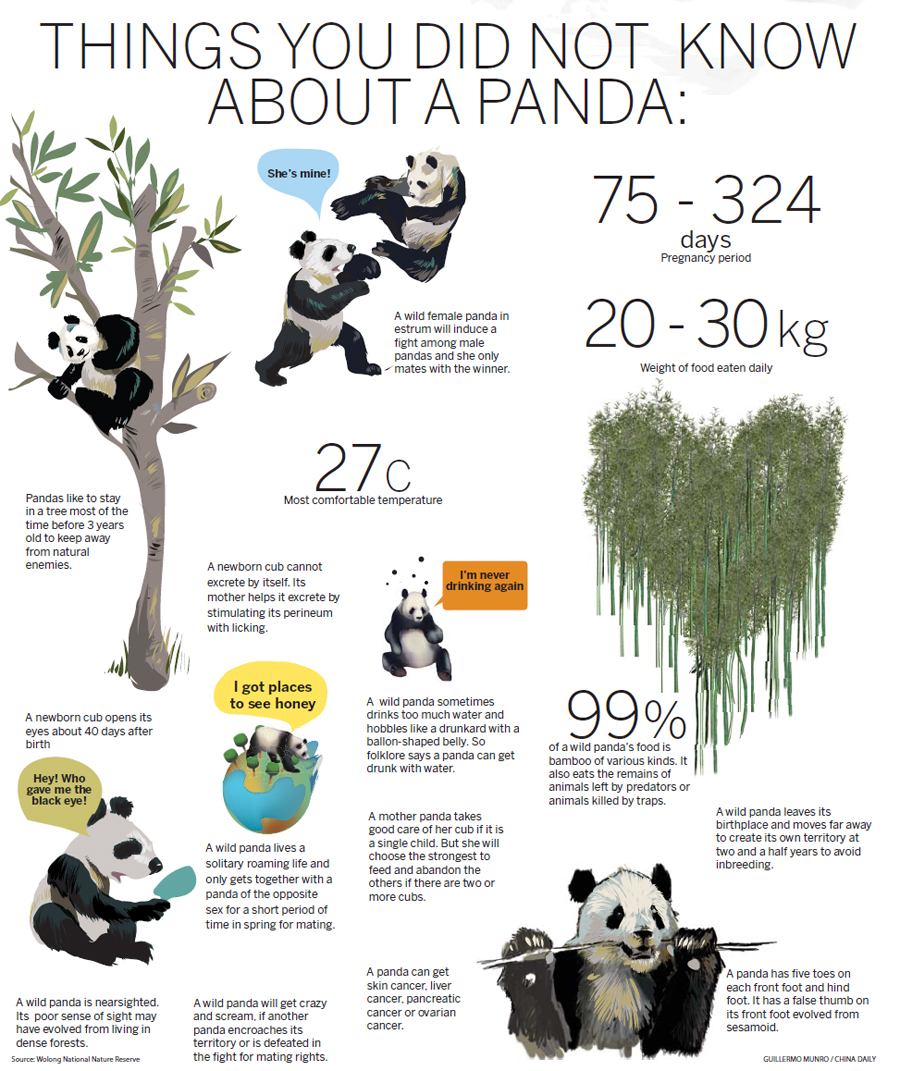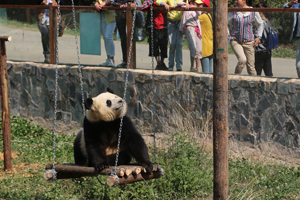Giant pandas going wild
Updated: 2014-05-03 08:46
By Huang Zhiling (China Daily)

"Since we could not choose the bamboo for captive pandas, we created a biscuit rich in trace elements and vitamins for them," he said.
Wild pandas stay active for hours each day. To emulate their natural environment, researchers tried putting the biscuits in places the pandas could not find easily, aiming to get them to move around. Some unorthodox approaches were also tried.
"To make them play, we froze fruits before giving them to the pandas. They had to play with the fruits until they thawed if they wanted to eat," Zhang said.
It the past, many newborn panda cubs died because of a quirk bred by nature. While 50 percent of newborns are twins, a mother typically chooses to care for only one. "In the wild, a mother panda first tries to care for both babies. But several hours later, she realizes she can't. If she tried to support both, both would die. So the mothers will desert one baby even if it cries," Zhang said.
Initially, researchers did not know how to handle the abandonment problem. And the death rate was high. They settled on a course that was part philanthropy and part trickery. They would take away the deserted baby and feed it milk. Then they would switch it with the favored cub from time to time. In this way, the mother unwittingly supported both.
"Researchers also emulated the mother panda in other ways. For example, the mother would lick different parts of the newborn cub, including its anus to get its droppings out. Researchers used a cotton stick to touch the deserted cub and to get the droppings out. This effort ensured the cubs' survival," Zhang said.
With the three primary obstacles hindering the breeding of captive pandas now overcome, the center has been able to develop a self-sustaining and growing panda population.
It is now home to 187 captive pandas out of a world total of 376, according to Zhang.
With the largest captive panda population in the world, the center no longer captures wild pandas for research purposes. Instead, it does the reverse, sending captive pandas into the wild with the aim of enlarging the natural panda population.
Tao Tao, a 2-year-old male panda from the center, was released into the wild in the Liziping Nature Reserve in Shimian county, Sichuan, in October 2012. He was discovered in a tree more than 3,000 meters above sea level on Oct 30, 2013.
A veterinarian, who was part of a team of researchers, tranquilized the frightened bear with a rifle dart, and Tao Tao fell into a net. A blood test showed the panda was in good health, said Yang Zhisong, an associate professor of zoology at China West Normal University in Nanchong, Sichuan, which contributed to the team.
Tao Tao weighed 42 kg when he was released in 2012. When he was found a year later, he had gained at least 10 kg, Yang said.
Sichuan is home to more than 80 percent of the world's wild pandas. The rest are in Gansu and Shaanxi provinces. Pandas survive solely in six mountain ranges within Sichuan, Shaanxi and Gansu, in habitat measuring about 23,000 square kilometers. They inhabit the Qinling, Minshan, Qionglai, Daxiangling, Xiaoxiangling and Liangshan mountains.
The Chinese government has built 64 nature reserves in the provinces that cover 60 percent of the natural habitat of pandas and 70 percent of wild pandas, according to Liu Yawen, deputy director of the Department of Wildlife Conservation and Nature Reserve Management in the State Forestry Administration.
Contact the writer at huangzhiling@chinadaily.com.cn.
|
 |
 |
 |
| Chinese, Belgian heads of state launch panda house | Zoo installs TV to cheer panda up | Backstreet Boys love China's pandas |